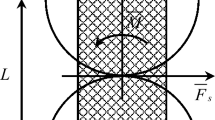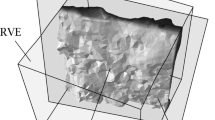Abstract
An aggregate generation and packing algorithm based on Monte-Carlo method is developed to express the aggregate random distribution in cement concrete. A mesoscale model is proposed on the basis of the algorithm. In this model, the concrete consists of three parts, namely coarse aggregate, cement matrix and the interfacial transition zone (ITZ) between them. To verify the proposed model, a three-point bending beam test was performed and a series of two-dimensional mesoscale concrete models were generated for crack behavior investigation. The results indicate that the numerical model proposed in this study is helpful in modeling crack behavior of concrete, and that treating concrete as heterogeneous material is very important in fracture modeling.
Similar content being viewed by others
References
Sadouki H, Wittmann F H. On the analysis of failure process in composite materials by numerical simulation. Mater Sci Eng A, 1988, 104: 9–20
De-Souza F V, Soares J B, Allen D H, et al. Model for predicting damage evaluation in heterogeneous viscoelastic asphaltic mixtures: bituminous paving mixtures. J Transp Res Board, 2004, 1891. 131–139
Kim H, Buttlar W G. Discrete fracture modeling of asphalt concrete. Int J Solids Struct, 2009, 46: 2593–604
Lopez C M, Carol L, Aguado A. Meso-structural study of concrete fracture using interface elements. I: Numerical model and tensile behaviour. Mater Struct, 2008, 41: 583–599
Simone A, Lloberas-Valls O, Rixen D J, et al. Domain decomposition techniques for the efficient modeling of brittle heterogeneous materials. Comput Method Appl M, 2011, 200: 1577–1590
Xiao J Z, Liu Q O, Tam V W Y. Numerical simulation on damage and failure of recycled aggregate concrete with a lattice model. Key Eng Mat, 2010, 417–418: 689–692
Tejchman J, Skarzynski L. Calculations of fracture process zones on meso-scale in notched concrete beams subjected to three-point bending. Eur J Mech A-Solid, 2010, 29: 746–760
Nguyen T D, Lawrence C, La Borderie C, et al. A mesoscopic model for a better understanding of the transition from diffuse damage to localized damage. Europ J Environ Civil Eng, 2010, 14: 751–776
Li P G, Wei S, Qing Y C. Multiscale material design and crack path prediction of a polymer-modified cementitious cover layer. Comp Mater Sci, 2010, 49: 184–189
Grassl P, Jirasek M. Meso-scale approach to modelling the fracture process zone of concrete subjected to uniaxial tension. Int J Solids Struct, 2010, 47: 957–968
Mo L T, Huurman M, Wub S P, et al. 2D and 3D meso-scale finite element models for ravelling analysis of porous asphalt concrete. Finite Elem Anal Des, 2008, 44: 186–196
Le T T H, Meftah B H F. A multi-scale thermo-hydral modelling of concrete behaviour at high temperature. In: 4th Biot Conference on Poromechanics. New York: DEStech Publications, 2009. 787–792
Dupray F, Malecot Y, Daudeville L, et al. A mesoscopic model for the behaviour of concrete under high confinement. Int J Numer Anal Met, 2009, 33: 1407–1423
Zhang R, Tang Z P. The macroscopic and mesoscopic multiscale simulation in fracture process of three-point-bending concrete beam. In: The 2nd International Conference on Heterogeneous Material Mechanics. Huangshan: DEStech Publications, 2008. 286–289
Stroeven P, He H, Guo Z, et al. Multi-scale coupled pore structure modeling approach to concrete; sketch of strategy and methodology, and examples. In: 1st International Conference on Microstructure Related Durability of Cementitious Composites. Nanjing: RILEM Publications S.A.R.L, 2008. 1199–1209
Riede W, Wicklein M, Thorna K. Shock properties of conventional and high strength concrete: Experimental and mesomechanical analysis. Int J Impact Eng, 2008, 35: 155–171
Ohtsu M, Uddin F A K M. Mechanisms of corrosion-induced cracks in concrete at meso- and macro-scales. J Adv Concr Technol, 2008, 6: 419–429
Gu X L, Yin X J, Jin X Y, et al. Multi-scale analysis of damage process for concrete structures. In: Proceedings of the Tenth International Symposium on Structural Engineering for Young Experts. Changsha: Science Press, 2008. 344–349
Grassl P, Rempling R. A parametric study of the meso-scale modelling of concrete subjected to cyclic compression. Comp Concr, 2008, 5: 359–373
Pedersen R R, Simone A, Stroeven M, et al. Mesoscopic modelling of concrete under impact. In: Proceedings of FraMCoS-6. Catania: Taylor & Francis Group, 2007. 571–578
Bernard F, Kamali-Bernard S, Prince W, et al. 3D multi-scale modeling of mortar mechanical behavior and effects of microstructural changes. In: Proceedings of FraMCoS-6. Catania: Taylor & Francis Group, 2007. 467–473
Author information
Authors and Affiliations
Corresponding author
Rights and permissions
About this article
Cite this article
Zhang, N., Guo, X., Zhu, B. et al. A mesoscale model based on Monte-Carlo method for concrete fracture behavior study. Sci. China Technol. Sci. 55, 3278–3284 (2012). https://doi.org/10.1007/s11431-012-5035-y
Received:
Accepted:
Published:
Issue Date:
DOI: https://doi.org/10.1007/s11431-012-5035-y




